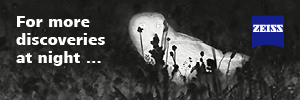| This article is incomplete. This article is missing one or more sections. You can help the BirdForum Opus by expanding it. |
Overview
One of the most popular birding localities in Canada, Point Pelee is a superb migration watchpoint with a wide range of waterfowl, waders, seabirds and passerines. This very small national park, covering less tha 20km2 is situated on the northern shore of Lake Erie and includes sandy beaches, freshwater marshes and deciduous forest.
Both parks are on Lake Erie. Just Wonderful for birding - Spring Migration is huge and the Predator Migration in the Fall Sept Oct is great.
Birds
Notable Species
Breeding birds of the park include Least Bittern, Wood Duck, Virginia Rail and Sora in the marshes and Orchard Oriole, Blue-gray Gnatcatcher and Yellow-breasted Chat in the woodlands. However, the main attraction of the area is migrants.
Regular migrants include Common Loon and grebes, waterfowl such as Tundra Swan, Redhead and Canvasback, Bufflehead and Hooded Merganser. Passage raptors include Cooper's Hawk, Sharp-shinned Hawk, Red-shouldered Hawk and Broad-winged Hawk. Warblers are well represented with Black-and-white Warbler, Prothonotary Warbler, Golden-winged Warbler, Blue-winged Warbler, Magnolia Warbler, Cape May Warbler, Pine Warbler and Palm Warbler among those regularly passing through.
Check-list
Birds you can see here include:
Common Loon, Horned Grebe, Pied-billed Grebe, Double-crested Cormorant, Great Blue Heron, Green Heron, Great Egret, Black-crowned Night Heron, Least Bittern, American Bittern, Tundra Swan, Canada Goose, American Wigeon, Green-winged Teal, Mallard, American Black Duck, Gadwall, Northern Pintail, Wood Duck, Redhead, Canvasback, Ring-necked Duck, Greater Scaup, Lesser Scaup, Common Goldeneye, Bufflehead, White-winged Scoter, Surf Scoter, Hooded Merganser, Common Merganser, Red-breasted Merganser, Ruddy Duck, Turkey Vulture, Bald Eagle, Sharp-shinned Hawk, Cooper's Hawk, Red-tailed Hawk, Red-shouldered Hawk, Broad-winged Hawk, Northern Harrier, American Kestrel, Northern Bobwhite, Common Pheasant, Sora, Common Gallinule, American Coot, Semipalmated Plover, Killdeer, Black-bellied Plover, Sanderling, Semipalmated Sandpiper, Dunlin, Pectoral Sandpiper, Least Sandpiper, American Woodcock, Wilson's Snipe, Short-billed Dowitcher, Greater Yellowlegs, Lesser Yellowlegs, Solitary Sandpiper, Ruddy Turnstone, Ring-billed Gull, American Herring Gull, Great Black-backed Gull, Bonaparte's Gull, Common Tern, Caspian Tern, Black Tern, feral Rock Dove, Mourning Dove, Yellow-billed Cuckoo, Black-bellied Cuckoo, Eastern Screech Owl, Great Horned Owl, Long-eared Owl, Eastern Whip-poor-will, Common Nighthawk, Chimney Swift, Ruby-throated Hummingbird, Belted Kingfisher, Northern Flicker(yellow-shafted form), Red-headed Woodpecker, Yellow-bellied Sapsucker, Hairy Woodpecker, Downy Woodpecker, Eastern Kingbird, Great Crested Flycatcher, Eastern Phoebe, Yellow-bellied Flycatcher, Alder Flycatcher, Willow Flycatcher, Eastern Wood Pewee, Bank Swallow, Northern Rough-winged Swallow, Barn Swallow, Tree Swallow, Cliff Swallow, Purple Martin, American Pipit, Sedge Wren, Marsh Wren, Carolina Wren, Winter Wren, House Wren, Gray Catbird, Brown Thrasher, Eastern Bluebird, Veery, Gray-cheeked Thrush, Swainson's Thrush, Hermit Thrush, Wood Thrush, American Robin, Blue-gray Gnatcatcher, Golden-crowned Kinglet, Ruby-crowned Kinglet, White-breasted Nuthatch, Red-breasted Nuthatch, Brown Creeper, Snow Bunting, Fox Sparrow, Song Sparrow, Lincoln's Sparrow, Swamp Sparrow, White-crowned Sparrow, White-throated Sparrow, Dark-eyed Junco(slate-colored form), Savannah Sparrow, Henslow's Sparrow, Grasshopper Sparrow, American Tree Sparrow, Chipping Sparrow, Field Sparrow, Clay-colored Sparrow, Vesper Sparrow, Eastern Towhee, Rose-breasted Grosbeak, Indigo Bunting, Scarlet Tanager, Black-and-white Warbler, Golden-winged Warbler, Blue-winged Warbler, Tennessee Warbler, Orange-crowned Warbler, Nashville Warbler, Northern Parula, Yellow Warbler, Chestnut-sided Warbler, Cerulean Warbler, Black-throated Blue Warbler, Pine Warbler, Black-throated Green Warbler, Cape May Warbler, Blackburnian Warbler, Magnolia Warbler, Yellow-rumped Warbler, Palm Warbler, Blackpoll Warbler, Bay-breasted Warbler, American Redstart, Ovenbird, Northern Waterthrush, Prothonotary Warbler, Common Yellowthroat, Wilson's Warbler, Canada Warbler, Yellow-breasted Chat, Red-eyed Vireo, Blue-headed Vireo, Yellow-throated Vireo, Philadelphia Vireo, Warbling Vireo, Baltimore Oriole, Orchard Oriole, Red-winged Blackbird, Eastern Meadowlark, Common Grackle, Rusty Blackbird, Brown-headed Cowbird, Bobolink, Pine Siskin, American Goldfinch, Common Redpoll, Purple Finch, Evening Grosbeak, American Crow
Other Wildlife
Monarch Butterfly migration is a wonderful addition in Sept.
Site Information
Mid-March to the end of May and mid-August until the end of September are the peak times to visit
History and Use
To do
Areas of Interest
To do
Access and Facilities
Point Pelee can be reached by road south of Leamington. Accommodation can be found at Leamington and other local towns.
Contact Details
Tel: 519-322-2365
External Links
Content and images originally posted by Steve and lynnland88
Reviews
Radley's review
Without doubt Point Pelee is the best place in North America for viewing and photographing spring migrant passerines. More than 300 species of birds have been recorded at the park. I don't know where the description above came from but I marvel at its lack of accuracy. At least 30 species which nest in and adjacent to the park are listed as migratory/rare when, in fact, they are common residents.
Pros
- Spectacular spring migration.
Cons
- Very busy on weekends during May.



